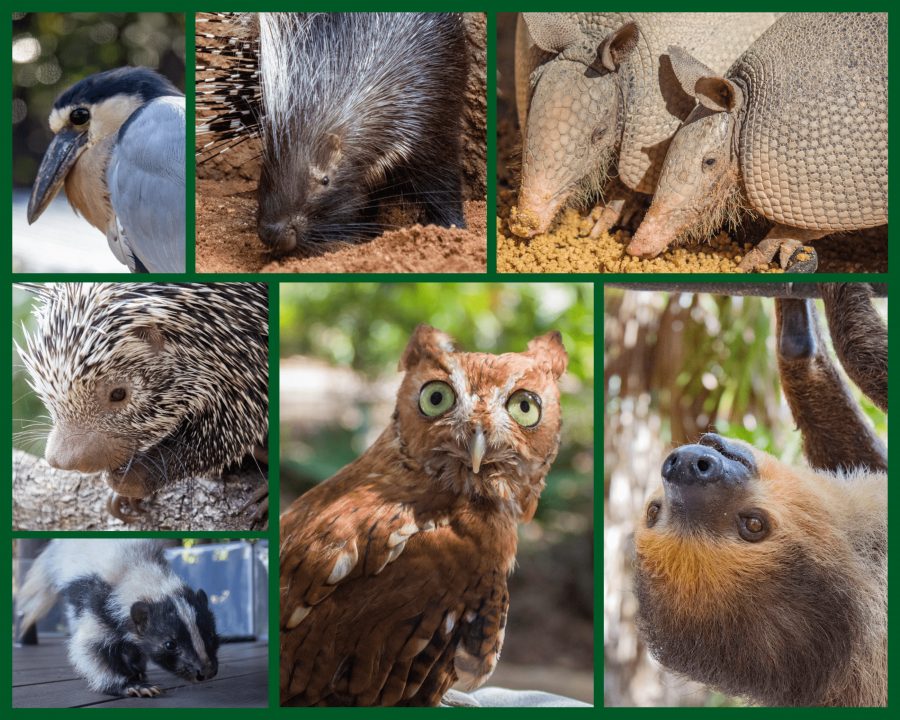

Have you spotted all of these sleepy species at our Zoo?
Let’s introduce you to some of the more hidden faces around the Zoo! Our Linne’s two-toed sloths, boat-billed herons, screech owls, Brazilian and cape porcupines, striped skunks and armadillos are a few of our nocturnal species, meaning they’re all typically sleeping during your Zoo visit!
Today, we want to break down what life is like for some of our nocturnal Zoo residents since many are hidden from your view.
Our keepers start their mornings by checking in on some of our daytime nappers in each of their loops. They make sure to monitor how much food is consumed overnight and offer some diet items in the morning.
Trail cameras are also set up in the necessary habitats to document what these residents get up to during the night (hint: it’s a lot of eating.) This footage can take about an hour or more to review, but it is not essential to watch through every day. Extra attention is placed on this footage if an animal is documented to have a weight drop, a decrease in food consumption, or abnormal fecals.
Our Wild Florida keepers will also usually dig up our armadillo friends twice a week to physically see them and assess their health in person, since they spend most of their time underground in their burrows. However, the camera monitoring system has still changed the game when it comes to animal wellbeing.
“Using our more hands-off camera monitoring approach has opened the doors for a lot more choice and control in our armadillos’ daily lives. They have the option to leave the burrow during the day or not. They can decide when they get up to forage for food or interact with enrichment items,” said Senior Wild Florida Keeper Christen Carrillo.
Overall, the camera monitoring system has been integral to documenting our animals’ health. But it can also be entertaining to watch these animal residents’ midnight antics.
It might surprise you to see how active these species can be in the dark. While our boat-billed herons will mainly sleep perched when you get to observe them, at night they fly around their habitat looking for snacks (mainly fish by their pool), bathe in their pond, or interact with each other. Our sloths have a calmer personality, but they will wander around their ropes opening puzzle feeders and investigating other areas of their habitat. Even the skunks below get busy collecting any food that Shelley the Brazilian porcupine or the sloths have dropped from their tree-top perches.
Herps and Aquatics Keeper, Jordan Lowery, loves to watch what our two screech owls are up to overnight.
“They do a lot of short flights all night long and cache, or store, their leftover dinner in hiding places around their habitat. Screech owls are also great insect hunters, so they keep busy chasing down the flying bugs that come out at night, too,” she said.
Once our keepers make sure that everyone is in tip-top shape, they can do some routine training with their animal residents. Since training does take place during the day, some of these nocturnal animals have become adjusted to waking up during the day to interact with their keepers and take a few motivational snacks. They usually enjoy being active, as this has become routine for them!
“Training is choice-based. Although they often are willing and eager to wake up and join us for a session, they sometimes choose to nap instead, which is fine! In that case, we would come back later and try again,” said Ambassador Keeper Jennifer Poole. “It may take a little extra overnight monitoring and some trial and error regarding finding their preferred times of day to engage with training sessions, but that is part of the fun of being a zookeeper!”
It’s important to work training into all our animals’ schedules so their minds and bodies stay active. Training also builds a positive relationship with trainers and allows them to monitor their health without using more invasive procedures.
To make sure their sleep schedule is as undisturbed as possible, we allow most of these animals access to a behind-the-scenes shelter where they can take quiet naps in. If they don’t have a night house, then they have plenty of noise-free locations where they can rest and hide in peace.
Our nocturnal ambassador animals (the sloths, Brazilian porcupine and skunks) often work the night shift when attending special events. Due to these residents’ special duties as ambassadors, they have gotten more used to waking up during the day when snacks are present. However, if they do choose to stay in, our keepers respect their choice and take another willing ambassador animal to the event.
While it can seem like a challenge to give our nocturnal animals the same quality of care as their diurnal counterparts, Assistant Curator of Animals, Sidnee Santana-Mellor, disagrees. “I don’t believe it’s harder mainly because we have the technology to monitor animals overnight, and we can make changes as we see fit. We also prioritize having positive relationships with our animals, which works in our favor when they are normally sleeping.”
“Getting to recognize and work with everyone’s needs and preferences is a fun puzzle-solving experience for us – great enrichment for us keepers,” added Jennifer.
Hopefully, you learned a little bit about each of these seven species’ experiences with us as nocturnal animals. Can you spot them all on your next Zoo visit?
Special thanks to Flammio Financial Group, Stifel-Garvin Wealth Management Group, Artemis IT, and Jim and Darleen Barfield. Their generosity makes our work possible!
Brevard Zoo is an independent, not-for-profit organization that receives no recurring government funding for our operating costs. Your generous support enables us to continue to serve our community and continue our vital animal wellness, education and conservation programs.
